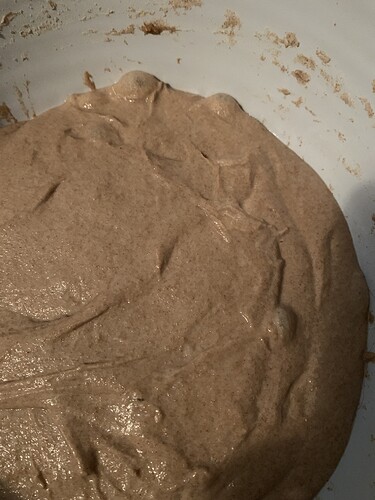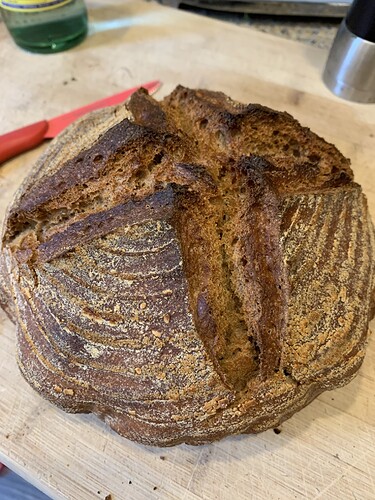This method has been a revelation to me!! I have tweaked the flours, etc. to meet my own needs, but am using the method as written. Baking the best bread of my life. Both the flavor and the texture are so much better than with more-standard recipes. Thank you so much!!
Dave
Just a quick question. I am very new to sourdough baking and am a bit overwhelmed with tools. I noticed you are using a simple cast iron pan. Do you use a cover?
Thank you
@homebreadbaker Paul, I’m increasingly intrigued by this technique of yours. I haven’t tried it yet because I have a question.
My stand mixer does not have a dough hook, just a whisk. It’s 47+ years old  What I do have is a 25+ year old Welbilt Bread Machine with a manual cycle that can be used for kneading. Though the speed isn’t adjustable, could I use that machine for kneading the dough instead of a stand mixer? That’s what I do when I make my sourdough pitas. I’m thinking it would be the perfect solution for this recipe too.
What I do have is a 25+ year old Welbilt Bread Machine with a manual cycle that can be used for kneading. Though the speed isn’t adjustable, could I use that machine for kneading the dough instead of a stand mixer? That’s what I do when I make my sourdough pitas. I’m thinking it would be the perfect solution for this recipe too.
Blessings,
Leah
I’ve only ever mixed bread dough two ways: with my hands and with a new-ish Kitchenaid stand mixer with a dough hook. So that’s the only experience I have to draw on. I don’t think there is anything in this slow, lazy, sourdough method that is picky about how the dough is mixed and kneaded though. I would think your Bread Machine that lets you knead dough would work fine. Hand-mixing works fine too, if you are willing to let go of some of the lazy part.
@homebreadbaker Thanks, Paul. I’m glad to know that using my Bread Machine to do the kneading is a good option. Now to get the “nerve” to try another way of making my bread. I’ve gotten so used to the recipes I’ve been making that I practically have them down to a science. I have both Turkey Red and Hard White berries in my freezer that I can mill which I think would work well in your recipe.
Blessings,
Leah
I think turkey red would be a drop-in substitute for red fife in the recipe for this bread without any adjustments needed.
If you try it, coming from more conventional sourdough methods and measurements, I’d say two things: 1. use a really tiny amount of starter (think of it as an infection instead of an ingredient); and 2. relax and have faith when you watch the resulting dough sit there for hours with nothing appearing to happen.
Yes thats the Lodge Combo Cooker. I pre-heat the pan and cover, to cook with steam, then remove the cover to cook without steam.
@homebreadbaker - I’m in the middle of making my first loaf of Turkey Red with this method and am perplexed about the bulk fermentation time. After 6 hours overnight the dough was a bit puffy looking and very jiggly, yet there hadn’t been much of any rise. I did three stretch and folds and it’s now been a total of 8.5 hours. There are three bubbles along the edge - but still not that much rise. Do the bubbles alone indicate that it’s time to shape and refrigerate? FYI, I used 5g unfed cold starter to 1000g flour, 850g water and 21g salt. One other question - is there a reason you don’t do a pre-shape? Thanks!
My guess is those bubbles are artifacts of your stretch and folds. It’s a little hard to tell without actually touching the dough, but from the picture, I’d say that dough is still too early in bulk to shape. If your starter is good, the dough will rise.
I sometimes do a pre-shape, but mostly I just turn the dough out and kind of run the pre-shape and shape altogether. I create a round and then kind of pull it into a batard shape and just flip it over into the basket. Lazy-ness; and I’ve found that to work fine.
I’ll leave this up to @homebreadbaker but 5g to 1000g flour is going to take a very long time. 20g to 500g flour and you’re looking at around 10-12 hours. You have 1/4 of the starter and 2x the flour. Plus you’re doing 100% turkey red which is going to be quite a different result altogether. Too many changes and variables!
If you had done 5g starter 200g Turkey Red and 300g bread flour and left it 12-16 hours that’s be a much more well balanced recipe and time frame.
Thanks Abe. I based it on Paul’s use of 2-3g for 600g flour. We will see! @homebreadbaker - the bubbles appeared after hour six so I don’t think they are due to the folding. They seemed to happen after I raised the temperature a bit - the 7-hour overnight temp was about 69 degrees but then I put it in the proofing box at 73 for the last few hours.
At 69F for most of the bulk, my guess is that it hasn’t really started yet. I’d suggest to keep watching it and expect it to rise; it can take a long time. At that temp I will often have 14 - 16 hour bulk proofs and most of that time it looks like nothing is happening.
Ok I will be patient. Thank you for being my real-time baking consultant!
Update: I shaped it at 15 hours. Extremely bubbly and maybe 1/3 rise. Was incredibly full of air - but crazy soupy, so deflated as I shaped. Will probably proof in fridge for 16 hours and bake it in the morning, though tempted to cut it off before bed tonight because I’m worried it overproofed. The endless debate!
Pretty good result! 15 hours bulk, 14 hours fridge proofing at 38. I usually get a bit more oven spring but am happy with this. How does this crumb look to you?
Looks great @cathy.elton. Great crumb for a 100% wholegrain bread. I’d be very happy with that. Enjoy!
What @Abe said. That looks great to me too. Notice any difference in flavor vs. other whole grain methods you’ve used in the past?
A bit more sour for sure. It’s really delicious. By the way, I don’t find this method “lazy” - it’s almost the same amount of steps as any sourdough, other than making levain. The steps are just spread out over more time!
LOL, well, making bread is making bread. As I wrote in the (too long) intro, for me this is the “laziest” set of compromises I’ve found that still gives me good results. I think if I wanted to get a little lazier, I’d increase the hydration some and eliminate the stretch and folds to make it a no-knead, but I actually like doing some minimal dough handling to keep me in touch with the proofing process.
Mainly though, what seems “lazy” to me compared with how most sourdough bread methods reach into your life, has to do with the starter “management.” Which more or less has disappeared for me. No making levains anymore. No daily or weekly or even monthly feedings. I just refresh the tiny amount of starter in the fridge whenever I have a minute, on no schedule at all. I don’t worry about its activity, whether it is “mature” or “ripe” or “peak” or any of that rigamarole. When I want to make some bread, I just dip the tip of my spoon into the starter jar and stir that into the water for the dough. Compared with how most people seem to be sweating their “starter management” - even taking their jar of starter on vacation with them for fear of it “dying” - what I do seems different from all that in a way that I label “lazy” for lack of a better term.
Well, that’s true, I do tend to feed my starter twice a day, which is a pain. We will see if I totally switch to your lazy method for everything - I will try it with some other breads. Have you done it with something like the Tartine oatmeal porridge bread? My friends are obsessed with that so I bake it pretty often (with toasted almonds - delicious).
While I appreciate them from afar, I’m afraid that Chad Robert’s masterful methodologies are too involved for my lazy butt.
Starter is more of an actual ingredient in a lot of recipes and therefore substituting a tiny inoculation for a significant ingredient would likely require additional adjustments. Still, I think that the lazy sourdough idea could be adapted to a lot of different sourdough breads and recipes. It’s really more of an application of an understanding about what’s going on in a starter culture than anything else, and I think it’s most parsimoniously encapsulated (in practice) in something I’ve seen @Abe writing in the forum lately: watch the dough, not the clock.
In my demystifying sourdough bread baking post, I called that listening to the dough and I think that’s really the most basic “skill” that a beginning sourdough baker needs to develop. Once you have that feeling for how sourdough develops (proofs, ferments…), then you can bring it to any recipe or method and be more likely to get good results because you will be able to respond to what you see and feel rather than relying on some instructions on a stone tablet somewhere that can’t adapt to your kitchen at your temperature with your starter and your flour and your water and all the other your etceteras.


